

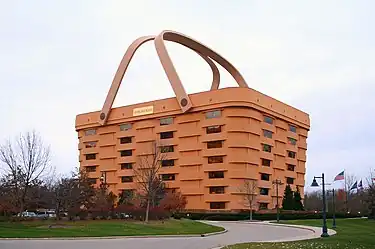
Novelty architecture, also called programmatic architecture or mimetic architecture, is a type of architecture in which buildings and other structures are given unusual shapes for purposes such as advertising or to copy other famous buildings without any intention of being authentic. Their size and novelty means that they often serve as landmarks. They are distinct from architectural follies, in that novelty architecture is essentially usable buildings in eccentric form whereas follies are non-usable, purely ornamental buildings also often in eccentric form.
Overview
Although earlier examples exist, such as the planned but never completed Parisian Elephant of the Bastille, the style generally became popular in the United States, and later to some other countries, as travel by automobile increased in the 1930s.[1] The Statue of Liberty in New York is a statue that is part sculpture and part monument, which like many subsequent examples of novelty architecture, has an accessible interior and became a tourist attraction.
Constructing novelty architecture near to roads became one way of attracting motorists to a diner, coffee shop, or roadside attraction, so buildings were constructed in an unusual shape, especially the shape of the things sold there. "Mimic" architecture became a trend, and many roadside coffee shops were built in the shape of giant coffee pots; hot dog stands were built in the shape of giant hot dogs; and fruit stands were built in the shape of oranges or other fruit. Tail o' the Pup mimics a hot dog-shaped hot dog stand; Brown Derby is a derby-shaped restaurant; Bondurant's Pharmacy is a mortar-and-pestle pharmacy; the Big Apple Restaurant and the Big Duck are, respectively, a 10.7 metres (35 ft) tall apple and a poultry store shaped like a duck (now a gift shop). Montréal has the restaurant Gibeau Orange Julep built as a 12-metre high orange-coloured truncated sphere in 1966 (replacing its smaller sphere of 1945) and still operating today.[1]
Novelty or programmatic (mimetic) architecture may take the form of objects not normally associated with buildings, such as characters, animals, people or household objects. Lucy the Elephant and The Longaberger Company's head office are examples. There may be an element of caricature or a cartoon associated with the architecture. Such giant animals, fruits and vegetables, or replicas of famous buildings often serve as attractions themselves. Some are simply unusual shapes or constructed of unusual materials.[1]
Many examples of novelty architecture are designed to attract drive-by customers by taking the form of products sold inside. Others, such as casinos in Las Vegas and Macau, are based on famous landmarks from around the world.
Categories
Buildings resembling objects or creatures
Mimetic architecture, or buildings designed to imitate a giant object or creature, sometimes having to do with what is being sold or showcased inside.
Examples include the High-Heel Wedding Church in Taiwan, the Mr. Toilet House in South Korea, the Museum of Tea Culture in China, the National Fisheries Development Board building and the Chowdiah Memorial Hall auditorium in India, the Elephant Building in Thailand, or the Wolfartsweier Cat Kindergarten and the BMW Headquarters in Germany, to name but a few.
Buildings styled after famous landmarks
Novelty architecture in the form of famous landmarks has been built in China, Georgia, Japan and the United States, for instance. Such replica buildings are extensively used in casinos, hotels, shopping plazas, or amusement parks such as Disneyland where the apparent playfulness and whimsy are intended to add to their appeal. In some cases, such as Carhenge, the structure is an adaptation of a well-known building.
In China, the New South China Mall in Dongguan, features a 25 metres (82 ft) replica of the Arc de Triomphe,[2] another replica of Venice's St Mark's Campanile,[3] a 2.1 kilometres (1.3 mi) canal with gondolas.[2]
In Batumi on Georgia's Black Sea coast, new high-rise landmark buildings and the renovation of the Old Town have incorporated novelty buildings.[4] Many of these constructions are novelty architecture, including the Sheraton Hotel, designed in the style of the Great Lighthouse at Alexandria, Egypt;[5] the Alphabet Tower (145 metres (476 ft) high), celebrating Georgian script and writing; Piazza, a mixed-used development in the form of an Italian piazza; and buildings designed in the style of the Leaning Tower of Pisa, the Acropolis, and an upside-down White House.
In Japan, there is the Huis Ten Bosch theme park near Nagasaki, which has replicas of Dutch landmarks like Huis ten Bosch and the Dom Tower of Utrecht.
In the US, a shopping plaza in Kansas City, Missouri contains a half-sized replica of La Giralda in Sevilla. Casinos on the Las Vegas Strip in the form of novelty architecture include the pyramid-shaped Luxor Hotel and the New York-New York Hotel & Casino, a building designed to look like the New York City skyline; Paris Las Vegas whose front suggests the Paris Opera House and the Louvre; and Excalibur Hotel and Casino (1990), with its stylized façade of King Arthur's castle (Camelot). In Macau, The Venetian Macao, like its counterpart in Las Vegas, features a replica of St Mark's Campanile and other buildings in Venice.
Water towers and storage tanks
Water towers and storage tanks, often prominent features in a small town, are two types of buildings which have been shaped or decorated to look like everyday objects. There are many versions of these types of novelty architecture.
Water towers exist in many forms, among them peaches, coffee pots, and teapots; corn cobs, wine bottles, and sauce bottles; and fishing bobbers and strawberries.
Several breweries and other businesses have designed holding tanks in the shape of giant cans of beer or other containers.
Giant sculptures
Sculptures of ordinary items scaled to building size are another aspect of novelty architecture. Such sculptures appear at roadside parks and attractions or museums in Australia, Canada, Japan, New Zealand, the Philippines and the United States. They are likely to represent local animals, such as fish or other wildlife; local plants, such as apples or pineapples; well-known local people such as Paul Bunyan; food, such as the branded candy bars at the former Curtiss Candy Company; sporting or mechanical equipment such as giant bats, balls, or tires; musical instruments, such as guitars; clothing, such as giant boots; or popular creatures, such as dinosaurs.
In some instances, the giant sculpture provides a reference for the building to which it is connected. Examples are the giant baseball bat outside the Louisville Slugger Museum & Factory and the giant paper plane at Cleveland Hopkins International Airport.
Other styles
Architecture popular in the 1950s-1960s in southern California and in Florida featured sharp corners, tilted roofs, starburst designs, and fanciful shapes. This came to be known as Googie, Doo Wop, or populuxe architecture.
Long-established firms whose features are well-known could still qualify as novelty architecture; examples include McDonald's original golden-arches design and the self-referential design of the White Castle restaurants.
Gallery
Buildings around the world
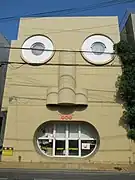 The Face House in Kyoto, Japan.
The Face House in Kyoto, Japan.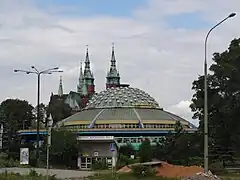

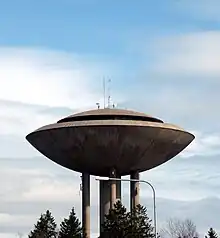
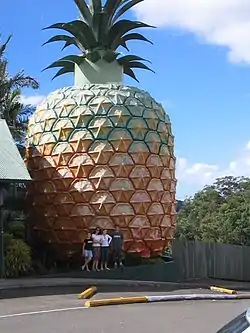
 Gibeau Orange Julep, Montreal, Quebec, Canada
Gibeau Orange Julep, Montreal, Quebec, Canada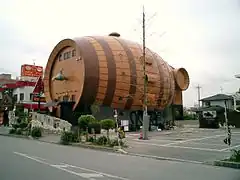 Large barrel-shaped bistro and bar in Okinawa City, Japan
Large barrel-shaped bistro and bar in Okinawa City, Japan
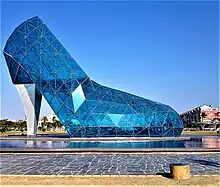 The High-Heel Wedding Church in Taiwan
The High-Heel Wedding Church in Taiwan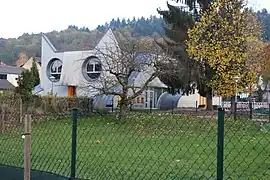 Wolfartsweier Cat Kindergarten in Germany
Wolfartsweier Cat Kindergarten in Germany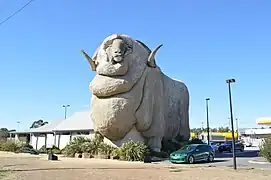
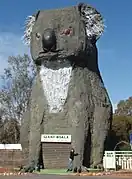 Giant Koala, Dadswells Bridge, Australia.
Giant Koala, Dadswells Bridge, Australia.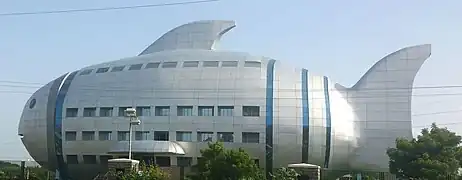
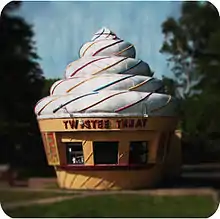 A Twistee Treat restaurant in Minden, Ontario, Canada
A Twistee Treat restaurant in Minden, Ontario, Canada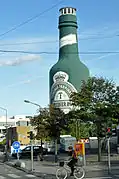 The Tuborg Bottle in Copenhagen, Denmark.
The Tuborg Bottle in Copenhagen, Denmark.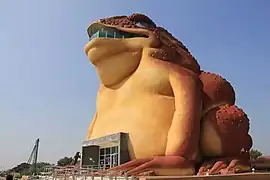
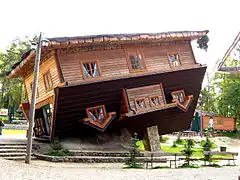
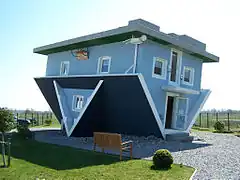 The Upside-Down House of Trassenheide, Germany[7]
The Upside-Down House of Trassenheide, Germany[7]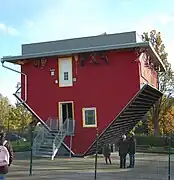 Rügen, Germany
Rügen, Germany
Buildings in the United States
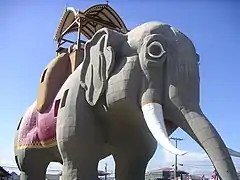 Lucy the Elephant in Margate City, New Jersey (1881)
Lucy the Elephant in Margate City, New Jersey (1881) The original Brown Derby in Los Angeles, California (1926)
The original Brown Derby in Los Angeles, California (1926)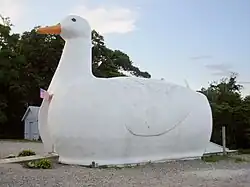 The Big Duck in Flanders, New York (1931)
The Big Duck in Flanders, New York (1931)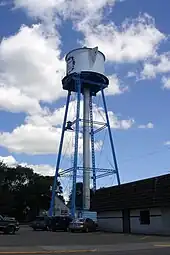 Coffeepot water tower in Lindstrom, Minnesota (1902)
Coffeepot water tower in Lindstrom, Minnesota (1902) Hot Cha Cafe, now Koffee Pot Cafe; Long Beach, California (ca. 1932)
Hot Cha Cafe, now Koffee Pot Cafe; Long Beach, California (ca. 1932) Corn cob water tower in Rochester, Minnesota (1931)
Corn cob water tower in Rochester, Minnesota (1931) World's Largest Catsup Bottle water tower in Collinsville, Illinois (1949)
World's Largest Catsup Bottle water tower in Collinsville, Illinois (1949)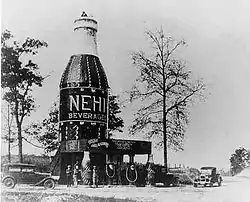 A 64-foot-tall (20 m) Nehi Bottle located near Auburn, Alabama, in an area referred to as "The Bottle" (destroyed by fire in 1933)
A 64-foot-tall (20 m) Nehi Bottle located near Auburn, Alabama, in an area referred to as "The Bottle" (destroyed by fire in 1933) Benewah Milk Bottle in Spokane, Washington (1935)
Benewah Milk Bottle in Spokane, Washington (1935)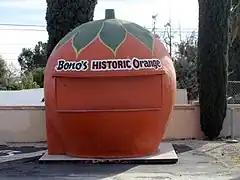 Bono's Orange Stand in Fontana, California (1936); used to sell California orange juice to hot drivers who all lacked air conditioning at that time.[8][9]
Bono's Orange Stand in Fontana, California (1936); used to sell California orange juice to hot drivers who all lacked air conditioning at that time.[8][9]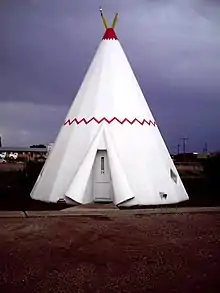 Wigwam Motel in Holbrook, Arizona (1950)
Wigwam Motel in Holbrook, Arizona (1950) Tail O' the Pup hot dog stand in California[10]
Tail O' the Pup hot dog stand in California[10]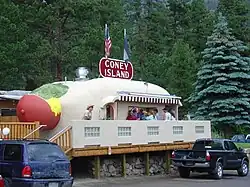 Coney Island Hot Dog Stand in Bailey, Colorado (1966)
Coney Island Hot Dog Stand in Bailey, Colorado (1966) At Cabazon Dinosaurs in Cabazon, California; this dinosaur's belly holds a souvenir shop
At Cabazon Dinosaurs in Cabazon, California; this dinosaur's belly holds a souvenir shop.jpg.webp) The Big Chicken in Marietta, Georgia
The Big Chicken in Marietta, Georgia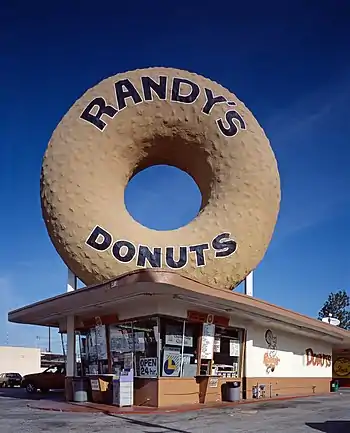 Randy's Donuts (1953) in Inglewood, California
Randy's Donuts (1953) in Inglewood, California
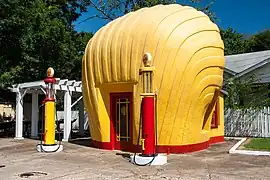
.jpg.webp) Kansas City Public Library's parking garage (2004) [11]
Kansas City Public Library's parking garage (2004) [11]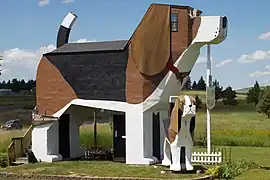 Dog Bark Park, Cottonwood, Idaho
Dog Bark Park, Cottonwood, Idaho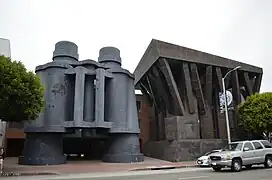
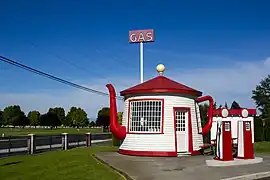 Teapot Dome Service Station in Zillah, Washington.
Teapot Dome Service Station in Zillah, Washington.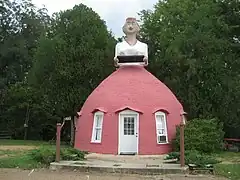 "Mammy's Cupboard" restaurant, Adams County, Mississippi (1940)
"Mammy's Cupboard" restaurant, Adams County, Mississippi (1940)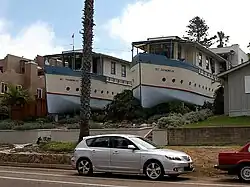
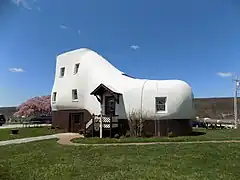
Statues
 Paul Bunyan and Babe the Blue Ox in Bemidji, Minnesota, US (1936)
Paul Bunyan and Babe the Blue Ox in Bemidji, Minnesota, US (1936)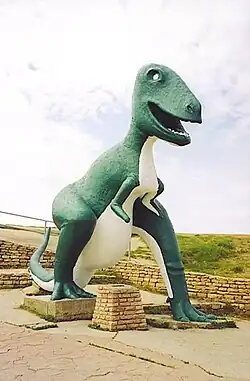 Dinosaur Park sculpture of a Tyrannosaurus rex in Rapid City, South Dakota, US (1936)
Dinosaur Park sculpture of a Tyrannosaurus rex in Rapid City, South Dakota, US (1936) Babe the Blue Ox at Trees of Mystery in Klamath, California, US (1949)
Babe the Blue Ox at Trees of Mystery in Klamath, California, US (1949) Golden Driller statue in Tulsa, Oklahoma, US (1953)
Golden Driller statue in Tulsa, Oklahoma, US (1953)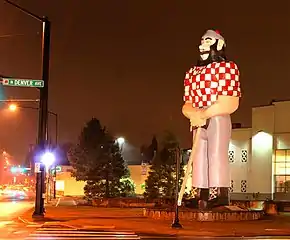 Paul Bunyan statue in Portland, Oregon, US (1959)
Paul Bunyan statue in Portland, Oregon, US (1959)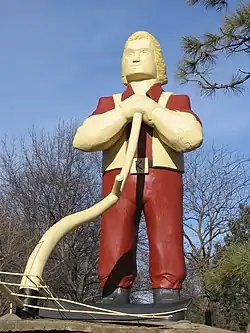 Johnny Kaw statue in Manhattan, Kansas, US (1966)
Johnny Kaw statue in Manhattan, Kansas, US (1966) Apatosaurus statue at North Carolina Museum of Life and Science in Durham, North Carolina, US (1967)
Apatosaurus statue at North Carolina Museum of Life and Science in Durham, North Carolina, US (1967) Paul Bunyan statue in Akeley, Minnesota, US
Paul Bunyan statue in Akeley, Minnesota, US Harvey statue at Harvey Marine in Aloha, Oregon, US
Harvey statue at Harvey Marine in Aloha, Oregon, US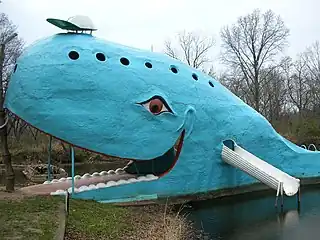
 World's Largest Dinosaur in Drumheller, Alberta, Canada (2000)
World's Largest Dinosaur in Drumheller, Alberta, Canada (2000)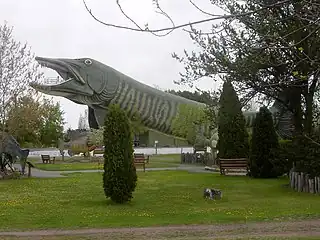 World's Largest Muskellunge in Hayward, Wisconsin, US at the National Freshwater Fishing Hall of Fame.
World's Largest Muskellunge in Hayward, Wisconsin, US at the National Freshwater Fishing Hall of Fame. Big fruit outside Cromwell, Central Otago, New Zealand
Big fruit outside Cromwell, Central Otago, New Zealand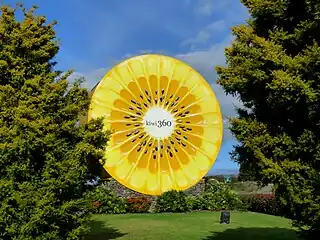 Kiwi fruit in Te Puke, New Zealand
Kiwi fruit in Te Puke, New Zealand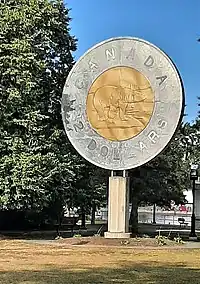
See also
- Australia's big things
- Ice hotels, temporary hotels made of ice and snow, found in the coldest regions of the world
- John Margolies, a photographer who specialized in roadside attractions, including novelty architecture
- List of world's largest roadside attractions
- Muffler Men, oversized molded fiberglass sculptures used to promote roadside businesses
- New Zealand's big things
References
- 1 2 3 Heimann, Jim (2001). California Crazy and Beyond: Roadside Vernacular Architecture. Chronicle Books. ISBN 0-8118-3018-7.
- 1 2 Matthew Benjamin and Nipa Piboontanasawat (April 17, 2007). "China's mall glut reflects an unbalanced economy". The New York Times. Retrieved February 8, 2010.
- ↑ Donohue, Michael (2008-06-12). "Mall of misfortune". The National. Abu Dhabi Media Company. Archived from the original on 2011-03-09. Retrieved 2010-01-12.
Location: Dongguan, China Year Opened: 2005 Gross Leasable Area: 7.1 million square feet
- ↑ Dinah Spritzer, "Next Stop: Glamour revives port of Batumi", New York Times, September 9, 2010.
- ↑ ""Sheraton Hotels & Resorts Debuts in the Black Sea Resort Destination of Batumi", Starwood Hotels and Resorts site". Archived from the original on 2013-01-04. Retrieved 2012-11-28.
- ↑ Cathy Adams. "Mimetic architecture: Why does this building look like a fish?". CNN. Retrieved 2021-11-12.
- ↑ "Upside-Down House of Trassenheide". Atlas Obscura. Retrieved 2023-12-26.
- ↑ Anicic, John Charles (2005). Fontana: Images of America. Mount Pleasant, South Carolina: Arcadia Publishing. p. 83. ISBN 0-7385-2900-1. Retrieved 2011-02-06.
- ↑ "Roadside America. Fontana, California - Giant Orange Stand". Roadsideamerica.com. Retrieved 2010-12-22.
- ↑ Cathy Adams. "Mimetic architecture: Why does this building look like a fish?". CNN. Retrieved 2021-11-12.
- ↑ Cathy Adams. "Mimetic architecture: Why does this building look like a fish?". CNN. Retrieved 2021-11-12.
- ↑ "These Unusual Houses Look Like Giant Boats That Washed Ashore On a Residential Street". Atlas Obscura. Retrieved 2023-02-14.
- ↑ "The Boathouses". Encinitas Historical Society & 1883 Schoolhouse. 2016-08-13. Retrieved 2023-02-14.
